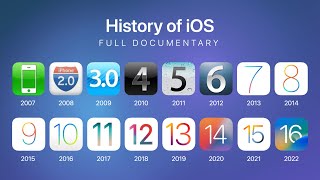Since its launch in 2007, Apple’s iOS has undergone significant changes and improvements to become one of the most popular mobile operating systems in the world. Let’s take a look at the evolution of iOS, from version 1 to the current version 16.
iOS 1
The first version of iOS was launched in 2007, along with the original iPhone. iOS 1 had a very basic interface and limited functionality, with only a few built-in apps like Mail, Safari, and iPod. There was no App Store, no copy and paste, and no support for third-party apps.
iOS 2
iOS 2, released in 2008, introduced the App Store, which revolutionized the way people use their iPhones. With the App Store, users could easily download and install third-party apps to extend the functionality of their devices. iOS 2 also added support for Microsoft Exchange, allowing users to sync their email, contacts, and calendars with their corporate accounts.
iOS 3
iOS 3, launched in 2009, brought several new features and improvements, including copy and paste, MMS support, and Spotlight search. The release of iOS 3 also introduced Voice Control, which allowed users to control their iPhones using voice commands.
iOS 4
iOS 4, released in 2010, introduced multitasking, allowing users to switch between apps without having to close and reopen them. iOS 4 also added support for FaceTime, a video-calling feature that allowed users to make calls using Wi-Fi. Other new features included the ability to create folders, unified inbox for email, and Game Center.
iOS 5
iOS 5, launched in 2011, brought several major new features and improvements, including Siri, Apple’s virtual assistant. iOS 5 also introduced Notification Center, iMessage, and iCloud, which allowed users to store their content in the cloud and sync it across their devices.
iOS 6
iOS 6, released in 2012, introduced Apple Maps, which replaced Google Maps as the default mapping app on iOS devices. iOS 6 also added Passbook, a new app that allowed users to store and manage their digital tickets, coupons, and loyalty cards.
iOS 7
iOS 7, launched in 2013, marked a major overhaul of the iOS interface. It introduced a new design language, with flat icons and translucent layers, and added several new features like Control Center, AirDrop, and iTunes Radio.
iOS 8
iOS 8, released in 2014, brought several new features and improvements, including a new Health app, QuickType keyboard, and Family Sharing. iOS 8 also introduced HomeKit, a framework for controlling smart home devices.
iOS 9
iOS 9, launched in 2015, introduced several new features and improvements, including a more intelligent Siri, a new News app, and enhanced multitasking for iPad. iOS 9 also introduced Low Power Mode, which helps to extend battery life on iPhones.
iOS 10
iOS 10, released in 2016, brought several major new features, including a redesigned lock screen, an improved Siri, and a new Home app for controlling smart home devices. iOS 10 also introduced a new feature called “Raise to Wake,” which wakes up the device’s screen when it’s lifted, making it easier to check notifications.
iOS 11
iOS 11, launched in 2017, brought several major new features and improvements, including a new customizable Control Center, a Files app for managing files, and a redesigned App Store. iOS 11 also introduced augmented reality (AR) capabilities, allowing developers to create immersive AR experiences for iPhone and iPad.
iOS 12
iOS 12, released in 2018, focused on improving performance and stability, but also introduced several new features and improvements, including Screen Time, which allows users to monitor and control their device usage, and Group FaceTime, which allows up to 32 people to participate in a video call at once.
iOS 13
iOS 13, launched in 2019, brought several major new features and improvements, including Dark Mode, a new swipe keyboard, and a redesigned Photos app. iOS 13 also introduced Sign in with Apple, a new privacy-focused login system, and improved location tracking options.
iOS 14
iOS 14, released in 2020, brought several major new features and improvements, including App Library, which automatically organizes apps into categories, and Widgets, which allow users to customize their home screens with interactive widgets. iOS 14 also introduced several new privacy features, including improved app permissions and a new privacy report feature.
iOS 15
iOS 15, the latest version of Apple’s mobile operating system, was released in 2021. It brings several new features and improvements, including FaceTime improvements, a new Focus mode for managing notifications, and Live Text, which allows users to interact with text in photos and images. iOS 15 also introduced several new features related to privacy and security, including App Privacy Reports and improved Siri privacy settings.
Conclusion
Over the years, Apple’s iOS has evolved from a basic mobile operating system with limited functionality to a powerful platform that supports a wide range of apps and features. With each new version, iOS has become more advanced and more user-friendly, providing users with new ways to communicate, stay organized, and entertain themselves. The evolution of iOS is a testament to Apple’s commitment to innovation and to providing its users with the best possible mobile experience.
